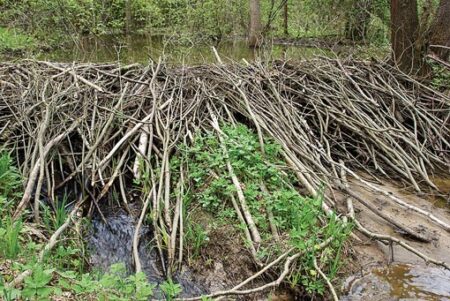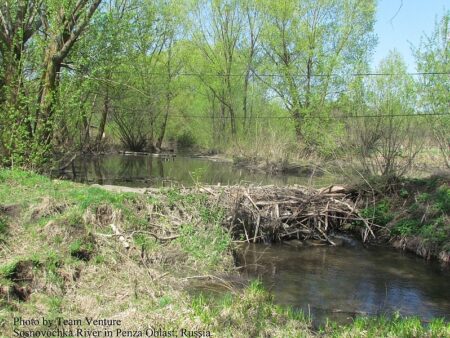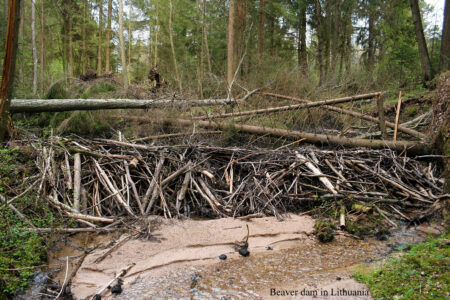Go to our Beaver Resource Hub for more information about beavers.
These bite sized facts and myths about beavers were extracted from two excellent books about beavers by Róisín Campbell-Palmer et al.
The Eurasian Beaver Handbook and The Eurasian Beaver
Beaver habitat
- Beavers live in rivers, lakes, marshes and ditches. Their basic needs are water and herbaceous and woody plants.
- Ideal beaver habitat is wooded valleys with slow moving rivers, or lakes with woodland.
- Beavers prefer slow moving water and prefer a gradient of 1 – 2%. They do not live in rivers with gradients steeper than 2.5%.
- Beaver territories range from 0.5km to up to 20km of shore or river-bank, average 3km. The size of their territory depends on winter food availability and the size of the surrounding beaver population.
Beaver dams, canals and tunnels
- Beavers only build dams when they need to in order to retain and manage water levels.
- If rivers are more than 10m wide beavers will build tunnels and burrows rather than dams. These tunnels can extend up to 20 metres (average less than 5m) into the bank to avoid flooding.
- Dams are made of sticks, branches, mud, stones and vegetation. Beavers will use features such as fallen trees, culverts, weirs and fish passes to assist with dam building.
- Beavers build networks of small canals to open up new feeding areas. They use the canals to transport food and building material to deep water.
- Canals may be dammed in times of drought to maintain water levels.
- Beaver dams vary in size but can be 1.5 – 2m high.
- Beaver dams can be permeable to a greater or lesser degree. Beavers are very good at plugging leaks in dams.
- Depending on the location and flow régime, beaver dams can be temporary and wash out in floods or become semi-permanent structures.
- Beaver ponds act as sediment traps unless/until the dam is breached when the sediment will be released downstream.
- Beaver tunnels, dams and lodges are abandoned when/if beavers move territory to find food.
- Beaver pond water is more susceptible to warming than the river upstream and can result in warmer water in the river downstream of the dam during the summer.
- Where there is sufficient space, streams may create by-pass channels around beaver dams.
- A beaver lodge can be a freestanding structure in a pool, within a dam or a chamber at the end of a tunnel.



Beaver breeding and predation
- Beavers become sexually mature at around 20 months and have one litter per year of 2 – 4 kits.
- Kits are predated by foxes, dogs, birds of prey and large pike. Otter, mink and badger may also possibly predate on kits.
- Beavers live in family groups with a breeding pair and offspring from the current and previous year. At 2 years old, young beaver disperse to find their own territories.
- Tail slapping is used as an alarm signal to warn other family members of danger.
Beaver feeding habits and impact
- Beavers do not eat fish. They eat the bark, shoots and leaves of woody (predominantly broadleaf) trees and shrubs along with herbaceous plants including aquatic vegetation. They store branches and twigs in underwater food caches to eat in the winter.
- Beavers will eat farmed crops in fields.
- Beaver tend to avoid conifers but may eat saplings or fell larger trees for building dams.
- Beavers can fell large trees (>1m diameter) but prefer saplings to eat the bark, branches and leaves. Most feeding takes place within 20m of the water’s edge.
- Beavers have the effect of naturally coppicing trees when they fell them for food.
- Beaver ponds create areas of wet woodland with live willow, birch and alder and dead woody material.
The video below shows beavers feeding on the River Otter in Devon.
Legal status of beavers
- In mainland Europe, beavers have been widely reintroduced and their conservation status is defined by the International Union for Conservation of Nature as of ‘least concern’.
- In Scotland, beavers are protected species but can be shot under licence.
- In England, beavers have been introduced under licence to enclosed areas.
- A wild (unfenced) population of beavers on the River Otter were permitted to remain by Defra in August 2020 following a five year trial period.
- A conservative population estimate of beavers in England is 200 (2020) but it is likely to be significantly more. Map of beaver locations in Britain.
Beaver Management
- In European countries where beavers have been established for 10 – 15 years, culling or hunting is carried out in order to control numbers.
- Many European countries pay landowners to support beavers on their land and/or compensate them for damage or loss of crops.
- Some countries in Europe provide incentives for farmers to leave a 10m riparian zone uncultivated to make space for the rivers and beavers.
- Best practice management (e.g. Bavaria) involves a network of people who provide advice and resolve conflicts with beavers.
- Beavers will build dams using existing structures including weirs, culverts and fish passes, potentially causing or exacerbating flooding or fish passage issues.
- Beaver dams can be reduced or removed where they cause issues such as inappropriate flooding, damage to roads or barriers to fish migration. However, beavers are diligent in reconstructing their dams so continued management is required.
- Beavers have their kits in the spring when sea trout and salmon smolts are migrating downstream. Smolts can become trapped or delayed at beaver dams where they are vulnerable to predation. There is potential for dam management conflict between breeding beavers and fish migration at this time of year.
- Individual trees can be protected from beaver damage by mesh or by painting the trunks with abrasive (sand) paint.
- Crops can be protected from beavers using temporary electric fences or permanent galvanised high tensile mesh fencing.
Beaver myths
- American beavers build dams but Eurasian beavers do not.
Eurasian beavers do build dams, but not all beavers build dams all the time – it depends on the habitat and the population of beavers. - Beavers eat fish.
Not true. Beavers are herbivores. - Beavers are rodents so will breed and reproduce quickly.
Beavers are rodents but they only have between 2 and 4 kits once a year. However, in most of Europe where beavers have been introduced a programme of culling is in place to manage their numbers. - Beavers mainly live in headwater streams in hilly areas.
Not true. Beavers prefer to live on low gradient rivers (1 – 2%) on floodplains. They will live in headwaters if that is the best or only habitat available to them. - Beavers result in more fish in the river.
Not exactly a myth, but not entirely true either. It depends on the local conditions and how they change with beaver impacts. Beaver ponds are good habitat for minnows, for example, and may be home to a single large trout. But beaver ponds may also drown out spawning and juvenile trout habitat and the dams can act as barriers to fish migrating upstream spawn or dispersing to find new habitat. They can also delay smolts and juveniles migrating downstream and make them more vulnerable to predation. Check out our main beaver page for trout/beaver interactions based on the available science.